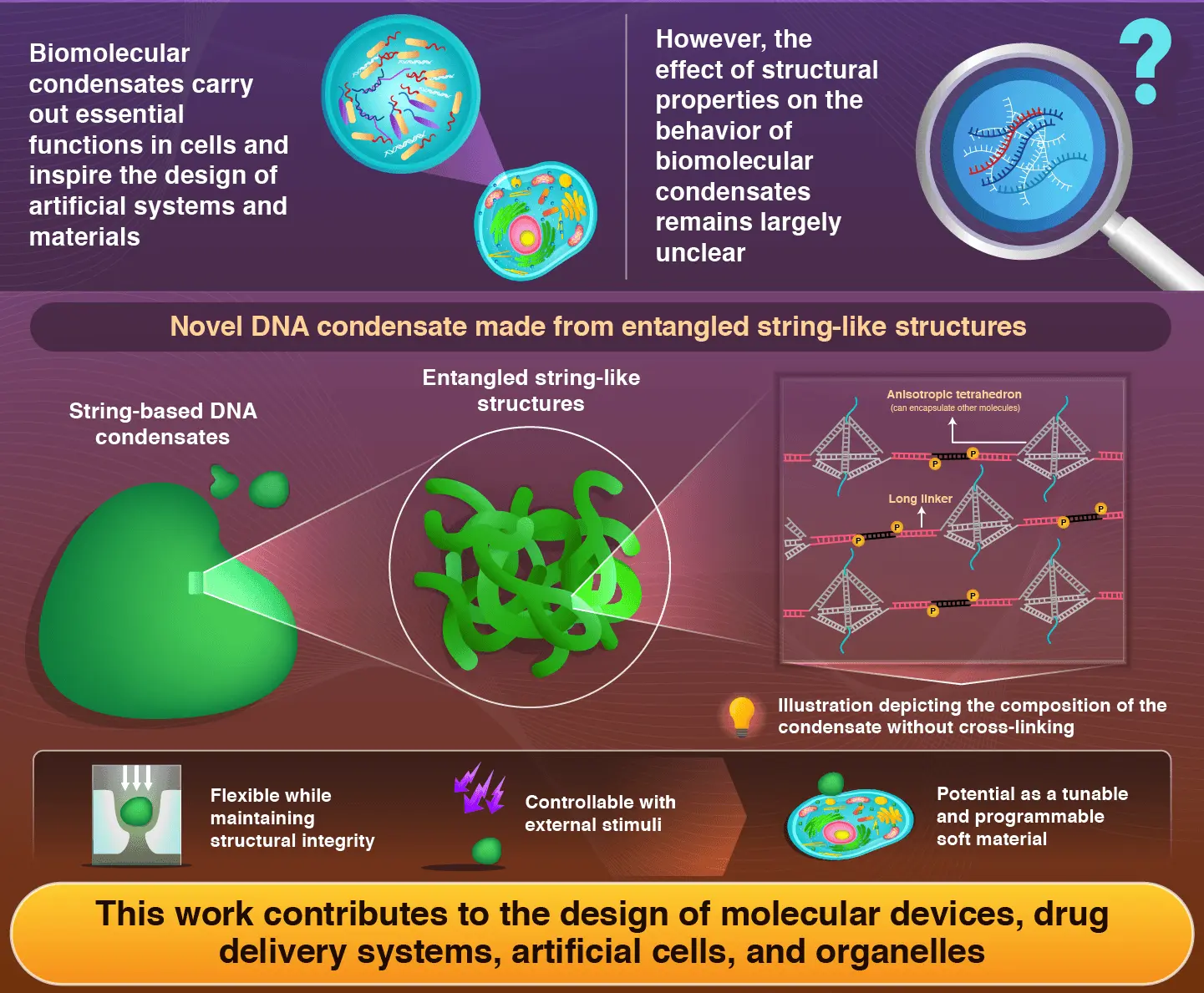Newly developed DNA nanostructures can form flexible, fluid, and stimuli-responsive condensates without relying on chemical cross-linking, report researchers from Institute of Science Tokyo and Chuo University. Owing to a rigid tetrahedral motif that binds the linkers in a specific direction, the resulting string-like structures form condensates with exceptional fluidity and stability. These findings pave the way for adaptive soft materials with potential applications in drug delivery, artificial organelles, and bioengineering platforms.
Engineering Versatile DNA-Based Soft Materials

Chai et al. (2025) | JACS Au |10.1021/jacsau.5c00421
Within living cells, certain biomolecules can organize themselves into specialized compartments called biomolecular condensates. These droplet-like structures play crucial roles in cellular functions, such as regulating gene expression and biochemical reactions; they essentially represent nature's clever way of organizing cellular activity without the need for rigid membranes. Scientists have become increasingly interested in creating artificial versions of these condensates using DNA nanotechnology, as DNA's programmability and precision make it an ideal building material for synthetic biological systems.
However, how the physical structure of condensate components affects their behavior and function is still unclear. Most synthetic DNA condensates created so far have been relatively uniform and lack the complexity found in living cells. Moreover, many biological condensates, such as those involving chromatin, contain highly anisotropic components—structures with directional properties that influence how the condensates form and behave. The effects of structural anisotropy have been largely overlooked in artificial condensates, limiting the potential designs of biomaterials with advanced functionalities.
In a recent study, a research team led by Professor Masahiro Takinoue of the Department of Computer Science at Institute of Science Tokyo (Science Tokyo), Japan, has made a significant leap forward in this field. Their work, published online in the journal JACS Au in Volume 5, Issue 7 on June 10, 2025, investigates how anisotropy in DNA nanostructures can influence DNA condensate formation and properties.
The researchers designed rigid, three-dimensional tetrahedral DNA nanostructures that connect in a specific direction to form string-like assemblies. Unlike the flexible X-shaped DNA motifs used in previous studies, these tetrahedral motifs maintain their rigid structure when linked together, creating long chains. A key innovation lies in how these strings interact: instead of requiring chemical cross-linking between different chains, the strings associate through physical entanglement to form phase-separated condensates.
Through various experiments, the team found that their DNA condensates exhibit remarkable properties compared to conventional ones. When subjected to mechanical stress, the string-based condensates could be stretched into fibrous structures without breaking, demonstrating exceptional flexibility and stability. Additionally, tests using microfluidic platforms revealed that these condensates could deform and squeeze through extremely narrow spaces, adapting to their environment in a fluid-like way that cross-linked condensates cannot. "The observed balance of flexibility and stability of the developed condensate may enable penetration and shape conformation to irregular tissue architectures, offering a viable option as a drug delivery vehicle," says Takinoue.
The researchers also demonstrated control over their condensates via external stimuli, including both ultraviolet (UV) light and temperature changes. By incorporating photocleavable spacers, they can trigger the disassembly of condensates using UV irradiation, releasing individual DNA nanostructures capable of penetrating cells. In addition, morphological changes of the condensate upon increasing temperature demonstrated its thermal responsiveness. These demonstrations suggest potential biomedical and soft material applications.
Overall, the findings of this study provide new insights into condensate behavior and design, opening up new possibilities for fine-tuning their properties for specific applications. "Our anisotropic tetrahedral DNA condensate represents a promising new soft material with potential applications across a wide range of fields, including bioengineering and artificial cell systems," concludes Takinoue. Future research and development will pave the way for novel molecular devices, drug delivery systems, and artificial organelles that more closely mimic the sophisticated organization found in living cells.
Reference
- Authors:
- Hong Xuan Chai1, Kanta Kayanuma2, Hiroaki Suzuki2, and Masahiro Takinoue1,3,4*
- Title:
- DNA Condensates via Entanglement of String-Like Structures Based on Anisotropic Nanotetrahedra
- Journal:
- JACS Au
- Affiliations:
- 1Department of Life Science and Technology, Institute of Science Tokyo, Japan
2Department of Precision Mechanics, Graduate School of Science and Engineering, Chuo University, Japan
3Department of Computer Science, Institute of Science Tokyo, Japan
4Department of Computer Science and Research Center for Autonomous Systems Materialogy (ASMat), Institute of Integrated Research, Institute of Science Tokyo, Japan






